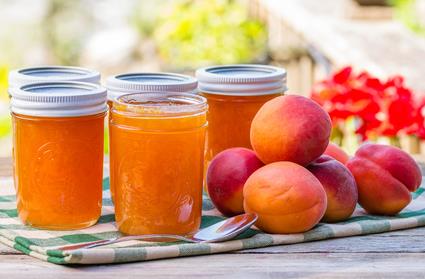It’s not all work, mow, eat, and sleep around here, contrary to my previous post. I broke away long enough to use my new toy and make a couple of batches of jelly and jam.
 If you’ve watched my story for a while, you know I started a new hobby last summer: canning. I threw myself into it and ended up with close to 200 jars of goodies that I have shared with family and friends. Making jam isn’t that hard but since my house survives on well water, my pots and jars were getting coated with hard water residue as I boiled, boiled, and boiled some more on my electric stove.
If you’ve watched my story for a while, you know I started a new hobby last summer: canning. I threw myself into it and ended up with close to 200 jars of goodies that I have shared with family and friends. Making jam isn’t that hard but since my house survives on well water, my pots and jars were getting coated with hard water residue as I boiled, boiled, and boiled some more on my electric stove.
To combat all that white film, I went the route of bottled water. That meant filling my big canning pot with bottled water, washing my jars and utensils with bottled water, and using bottled water where the recipes called for it. Even at Costco prices, all that water started to add up.
I splurged last month and bought myself something special just for my hobby. I purchased the Ball® FreshTECH Automatic Home Canning System.
Even after free shipping, 20% off, and some rewards points, it was still pretty pricy at $240. Yet it does something I have come to appreciate…it cans jellies and jams without steaming up my hot summer kitchen. Even with the jar sterlizing and processing, I’m only using 48oz of water. I use my stove for the cooking of the actual recipe. Everything else happens within the confines of the canner. I can make jellies, jams, pickles, canned fruits, salsa, and sauces. Recipes are included. Looking at it from a new user perspective, this method is very easy to learn. Just make your recipe, ladle into jars, push a few buttons and leave it alone. The canner does the rest. My stove is happy to get a break.
That’s the good news.
The bad news (for experienced canners) is I can’t use my own recipes and even with 60+ recipes in the canning book, the recipes are quite limited as many of them are duplicates (as in a strawberry jam recipe with a full sugar and a low sugar option. It’s still strawberry jam no matter how you look at it). For safety reasons the user is instructed not to try personal recipes in the automatic canner.
But I did anyway. Because I’m just that dangerous.
Actually, what I did was to use the Ball-provided recipe for grape jelly and substitute the grape juice with black currant juice. Yes, folks, you can get 100%, no sugar added, black currant juice on the market from the R.W. Knudsen Family and it makes fabulous jelly! Just as my sister and Husband #2. I have them hooked on the stuff. Currant jelly is kind of like the diva of the jelly world. Very hard to find and oh, so good.
Granted, I will watch that batch of currant jelly like a hawk. Any signs of spoilage and out it goes, including my dabbling in making my rebelious jelly in the automatic canner again. But for now, everything is holding up beautifully.
With that said, here is my non-Ball® FreshTECH Automatic Home Canner recipe for Black Currant Jelly. I have had great success with this recipe and using commercial juice. Just in case you like to can but prefer to do it the old-fashioned way.
- 5 cups black currant juice (no sugar added)
- 1 package (1.75 oz) regular powdered fruit pectin
- ½ teaspoon butter (to keep foam to a minimum. It really works! I have never had to skim off foam from my jellies/jams)
- 7 cups granulated sugar
Stir together juice, pectin, and butter in a large stockpot. Bring to a rolling boil. Once the liquid is hot enough to keep boiling without being stirred down, add sugar all at once. Bring to a boil again and stir constantly for 1 minute. I use a heat-tolerant spatula for stirring to really get into the corners of the pot. Once the jelly starts sheeting off of the spatula, it’s ready to process. Fill your prepared jars leaving ¼” headspace for expansion. Process jars in covered canner for 10 minutes. Then remove canner lid and let sit for 5 minutes. Remove jars and let cool. Check seals. Jelly should set up in 24 hours.
If you’re new to canning and want to give it a try, you can find a full tutorial here. Or if you’re a fan of the The Pioneer Woman go here for her excellent tutorial on canning and strawberry jam! Canning itself is not very difficult and if you’re worried about food poisoning, stick to high acid foods like fruits and tomatoes. Once you start getting into vegetables, you have to use a pressure cooker and that’s a whole different setup.
Quick note: What’s the difference between jelly and jam? Jellies are made from fruit juices and contain no bits of the original fruit. Jams are thicker and made from chunks of fruit. Both are relatively easy to make. And try this recipe if you want to make a small batch of raspberry jam with low sugar pectin.



Leave a Reply